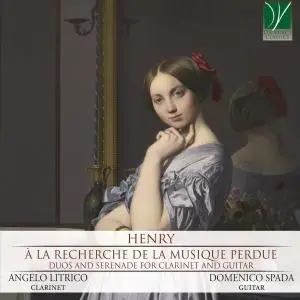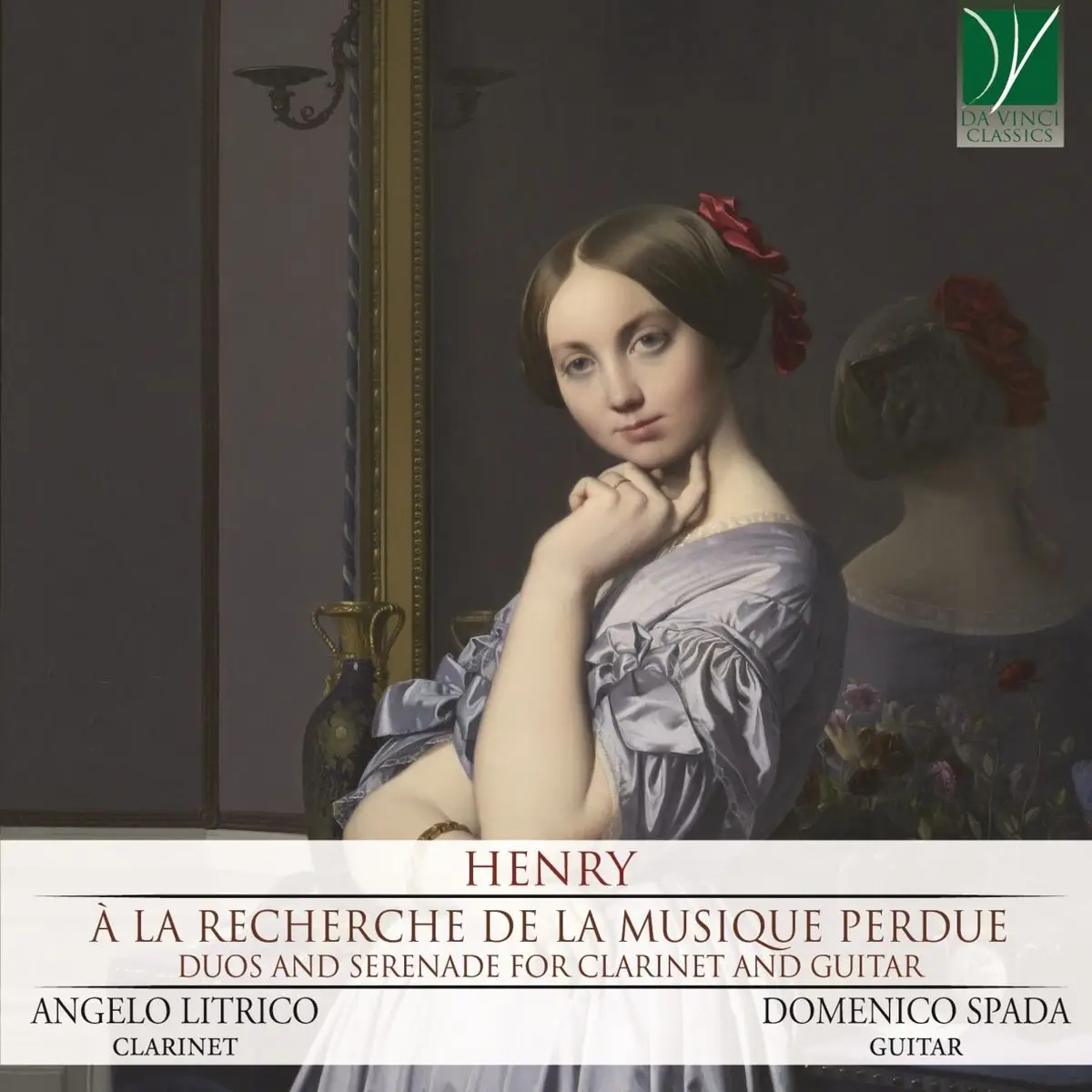Angelo Litrico - Henry: A la recherche de la musique perdue (2019)
WEB FLAC (tracks) - 277 MB | Tracks: 16 | 66:57 min
Style: Classical | Label: Da Vinci Classics
WEB FLAC (tracks) - 277 MB | Tracks: 16 | 66:57 min
Style: Classical | Label: Da Vinci Classics
It is a well-known pleasure for music lovers to discover hidden treasures; and it frequently happens that forgotten gems are found even within the output of well-known composers. But when the composer himself (or, intriguingly, herself..?) is in turn virtually unknown, then the adventure becomes even more attractive.
This is undoubtedly the case with the Henry who wrote the works in this Da Vinci CD, whose first name was unknown even to the compiler of the only biographical notice we have about him. (It is more likely that Henry was a man than a woman, since the clarinet was not among the instruments most frequently played by females at the time).
Contemporary research, in fact, could not go beyond the few lines we find in François-Joseph Fétis’ Biographie universelle des musiciens; indeed, the entries on “Henry” found in the most updated modern encyclopaedias express doubts on even the scanty facts given as likely by Fétis. In fact, Fétis ventures the hypothesis that our Henry might have been the son of Bonaventure Henry, a much better-known musician who lived in Paris between eighteenth and nineteenth century. Bonaventure taught violin, and acquired long-lasting fame for his talents as a pedagogue; his methods for violin were long recommended by famous performers as a formidable training for overcoming technical difficulties. Bonaventure had also a lively activity as a performer; his debut at the famous Concerts Spirituels (a series of concerts focusing on religious music) took place in 1780, when performed a Concerto composed by himself; later he was given a job as first violin at the Theatre Beaujolais, where he was still active in 1791. It is also possible that he was an entrepreneur in the field of musical publishing, since some works by one of the sons of J. S. Bach was published by “Henry” at the turn of the century. It has been hypothesized, moreover, that Bonaventure had a rather large and musical family, as several musicians with that family name and a suitable age were active in the early 1800s in Paris, among which one “citizen Henry” who is remembered as a female singer in the chronicles of the time.
In view of this information, Fétis’ belief that Henry the clarinettist might have been in turn one of the children of Bonaventure seems not to be too far-fetched, though no supporting information could be found. The halo of mystery surrounding the author of the works presented in this CD is increased by the fact that they are duos for clarinet and guitar. At the Bibliothèque Nationale of Paris, in fact, a certain number of solo and chamber music works for and with guitar are found under the family name of Henry, among which songs for voice and guitar, a method for guitar in thirty lessons and a collection of easy fantasies for solo guitar. The composer of these works is listed as “Professor of guitar”, as the pedagogical orientation of some of his output seems to confirm and to suggest; and since the opus number of the Mes fantaisies (op. 19) immediately precedes that of the Duos recorded in this CD, it seems likely that the same person authored both. On the other hand, however, Fétis’ record specifies that the author of the Duos was a clarinet player, and that he was so proficient in the technique of that instrument that he wrote solo Etudes and Caprices.
While the hypothesis that a single musician was extremely skilled in both instruments cannot be discarded, the very fact that the Duos recorded here feature both the clarinet and the guitar seems to suggest that two musicians, one playing the clarinet and one the guitar, may have been active at the same time and were likely related to each other as siblings. What is certain is that the amiable, delightful and gentle style of these works underpins the role of chamber music as an instrument and as a symbol for educated, cultivated and refined human relationships, mediated by music.
This musical dialogue between two very different instruments was so successfully realized in Henry’s music that an alternative version, for flute and guitar, was also published: the flute was a wind instrument more commonly played than the clarinet at the time, and therefore the potential audience of these Duos was substantially increased. Indeed, the original repertoire for clarinet and guitar duo is remarkably limited: this fact is hard to justify if one considers the particular beauty and fascinating blend that this instrumental combination offers, as is clearly demonstrated by the works in this CD.
The original choice of the clarinet as the chamber music partner of the guitar is however singularly fascinating and intriguing, though it is fully justified by the atmosphere of the time. In those years, in fact, Paris was becoming a major centre for the development of the instrument, which had been created approximately a century earlier in Germany and had been offered its first absolute masterpieces from the pen of Mozart at the end of the eighteenth century. A few years later, around 1810, an Estonian-born clarinet player and composer, Ivan Müller, arrived in Paris, and brought with him important technical innovations, which permitted to close more effectively the holes of the instrument and to realize an alto clarinet in E-flat. Two years later, in 1812, the same Müller further perfected his improvements, so that it became possible to perform the entire chromatic scale on a single instrument: the clarinet, thus, could play pieces in any key, whereas previously it was necessary to shift instrument for works in different keys. Sadly, however, the epoch-making revolution of Müller’s genius was initially not accepted at the Paris Conservatoire, as it was argued that the many instruments hitherto necessary for playing in the various keys possessed distinguishing, valuable and individual timbral qualities which should not be sacrificed in the name of practicality.
Notwithstanding this, the Paris Conservatoire would later impose itself as one of the poles for the exploration of new technical innovations and of their applications to musical performance and composition; in 1844, for example, it was the professor of clarinet at the Conservatoire, Hyacinthe Klosé, a famous performer and pedagogue, who first adopted the recently created Boehm system and contributed therefore to its success worldwide.
In the years when Henry was reportedly active in Paris, as maintained in Fétis’ Dictionnaire, then, the clarinet was under the spotlight for the new possibilities it offered. It is very significant, therefore, that a performing musician such as Henry was alert to these news opportunities and contributed generously to the repertoire for both entertainment purposes and the technical education of younger players.
The singing potential of the clarinet is fully exploited in these pieces, where melodic lines clearly influenced by the operatic style in their shape and structure are continuously interwoven with more virtuosic passages – in turn indebted to bel canto coloraturas. While the guitar frequently is in charge of the harmonic support, it is by no means confined to it, and it often enters into contrapuntal dialogue with the clarinet, thus providing these works with noticeable variety of style and creative ideas.
Although it is to be regretted, therefore, that the figure of the composer eludes so profoundly our knowledge, it is a pleasure that at least his music has survived, and that these delightful tunes and carefully crafted compositions are available for the enjoyment and cultural enrichment of today’s listeners.
Tracklist:
01. Duo, Op. 20 No. 1: I. Allegro moderato
02. Duo, Op. 20 No. 1: II. Andante con espresssione
03. Duo, Op. 20 No. 1: III. Rondo. Allegretto
04. Duo, Op. 20 No. 2: I. Allegro moderato
05. Duo, Op. 20 No. 2: II. Andante con espressione
06. Duo, Op. 20 No. 2: III. Andante con variatione
07. Duo, Op. 20 No. 3: I. Andante con espressione
08. Duo, Op. 20 No. 3: II. Allegro assai
09. Duo, Op. 20 No. 3: III. Sicilienne. Andantino
10. Duo, Op. 20 No. 3: IV. Rondo. Allegretto
11. Serenade, Op. 22: I. Allegro maestoso
12. Serenade, Op. 22: II. Rondeau. Allegretto
13. Serenade, Op. 22: III. Andante
14. Serenade, Op. 22: IV. Polaca
15. Serenade, Op. 22: V. Tempo di minuetto
16. Serenade, Op. 22: VI. Valse
FILE: 01. Duo, Op. 20 No. 1_ I. Allegro moderato.flac
Size: 40040302 Hash: B5D061F20D4D85613D8670DDFADB4D82 Accuracy: -m0
Conclusion: CDDA 100%
Signature: D75A4C503C9EED44A9580A44CD3F8DE1DB5094FC
FILE: 02. Duo, Op. 20 No. 1_ II. Andante con espresssione.flac
Size: 13803049 Hash: B928CB7DB5CC54036E25E06452F03A4B Accuracy: -m0
Conclusion: CDDA 100%
Signature: 5A38DC3FDD63FBDBB672EC9CD0FFE0629C7F9593
FILE: 03. Duo, Op. 20 No. 1_ III. Rondo. Allegretto.flac
Size: 19538806 Hash: 41D626E84DCFD3DF9106F3CEF4AABDC4 Accuracy: -m0
Conclusion: CDDA 100%
Signature: C33536AD2BBD1B7B641B84249248D3B9562CBF8B
FILE: 04. Duo, Op. 20 No. 2_ I. Allegro moderato.flac
Size: 38726095 Hash: 673063E57F674C4675B56E8101C39883 Accuracy: -m0
Conclusion: CDDA 100%
Signature: E56F1D734A2C34ED01BFB815D544D57FD9307B14
FILE: 05. Duo, Op. 20 No. 2_ II. Andante con espressione.flac
Size: 10480859 Hash: 06CCE8CAD8844CE383172F341E8D5218 Accuracy: -m0
Conclusion: CDDA 100%
Signature: 0D59975C4F10779689CE1FE29BDAC71F95E35EE2
FILE: 06. Duo, Op. 20 No. 2_ III. Andante con variatione.flac
Size: 29775173 Hash: B5D7765A21D526C2280B291AE27266FA Accuracy: -m0
Conclusion: CDDA 100%
Signature: F010EF9845B374EE46877E6323CF5BA58715EFC7
FILE: 07. Duo, Op. 20 No. 3_ I. Andante con espressione.flac
Size: 7749645 Hash: 8EA0F4AC02C196D48D50837E2E02B23C Accuracy: -m0
Conclusion: CDDA 100%
Signature: AB4A35A1DA8E3085401737D590B25AFAABD1AE02
FILE: 08. Duo, Op. 20 No. 3_ II. Allegro assai.flac
Size: 29128330 Hash: 3D181B2B3BC6139CA31A88E957B33398 Accuracy: -m0
Conclusion: CDDA 100%
Signature: A87A4425E4D4EC85C5F3E021E5385399134E6AC6
FILE: 09. Duo, Op. 20 No. 3_ III. Sicilienne. Andantino.flac
Size: 8494063 Hash: BE9CFA5DBC8969E1A61918DA9785CF60 Accuracy: -m0
Conclusion: CDDA 100%
Signature: FC823BC6EC6738182B1223C5A3DD3906E65C085E
FILE: 10. Duo, Op. 20 No. 3_ IV. Rondo. Allegretto.flac
Size: 17809579 Hash: 34F9F6E6CA49ADE83A7C5CA388FFE00F Accuracy: -m0
Conclusion: CDDA 100%
Signature: A007211146FEB5E87BFBE4DA85EC5E08395324BF
FILE: 11. Serenade, Op. 22_ I. Allegro maestoso.flac
Size: 13444823 Hash: 07A6916C146BBD7BE521850AB7F50D94 Accuracy: -m0
Conclusion: CDDA 100%
Signature: 72A6D73565588E9E405ADD2E1DCA3FF65EAA97FE
FILE: 12. Serenade, Op. 22_ II. Rondeau. Allegretto.flac
Size: 16004807 Hash: C1EADA8792D404B3A1623F3D36C935A0 Accuracy: -m0
Conclusion: CDDA 99%
Signature: 6F44138D87E91213A8188E9781BE2DE4DE9E07C3
FILE: 13. Serenade, Op. 22_ III. Andante.flac
Size: 8944810 Hash: 05C494A5271E17D42C9C855D76A7FB42 Accuracy: -m0
Conclusion: CDDA 100%
Signature: FB170A05A69AA4E5F028AAA916EF62AAFD7009DD
FILE: 14. Serenade, Op. 22_ IV. Polaca.flac
Size: 18955911 Hash: CF07C0E505E090CD67BB9B75B1741410 Accuracy: -m0
Conclusion: CDDA 100%
Signature: 2159929ED971530358C3FE8FE875B6A45C1CEB05
FILE: 15. Serenade, Op. 22_ V. Tempo di minuetto.flac
Size: 10743533 Hash: 2EE4191140E07C9FDA4865445EA37263 Accuracy: -m0
Conclusion: CDDA 100%
Signature: 6C3DC2B7B5016B6F9B682A40390699B9E5AE074B
FILE: 16. Serenade, Op. 22_ VI. Valse.flac
Size: 7675229 Hash: 50C29AB797B1961FAC8AB154B06A7117 Accuracy: -m0
Conclusion: CDDA 100%
Signature: 0745642DE281A6A5C4AED5E3D41B4F7371DE83F1



